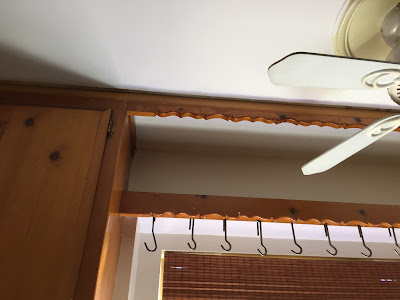I'm referring to the portions of ornamental casing on the base of several of the upper cabinets. They're a little too "country kitchen" for my design vision. I tried coming up with any likely name for them so that I could search online for ways to remove them.
No matter what combination of technical-sounding and common sense names I used, I couldn't find any posts or videos about getting them gone. This meant that either I was the first person on Earth to ever attempt such a procedure or, more likely, that it's something that couldn't or shouldn't be done.
But I wasn't about to let that stop me. One evening, in lieu of preparing dinner for myself, I stood in the kitchen sipping wine and studying the squiggles. What would happen if I just started prying them off? That method had worked out just fine with the half spindle. And I wasn't even drinking that time.
I started trying to wedge the blade of my painters tool into what I perceived the be the seam. It didn't give way and all I managed to do was chip the wood.
And break my (now empty) wine glass when I gave my prying attempt one last good heave, lost my grip, and threw the painters tool across the room.
It was then that DIY Dave texted me to show off some pictures of his newly installed kitchen cabinets and counters. I was all, "Good for you." Then, "What do I do here?" The text conversation that followed gave birth to the term squiggles, as well as a few lame solutions I won't mention. But the basic message DIY Dave tried to convey was that I couldn't remove them.
Stubbornly, I countered with pictures proving that I could. Including this one, which showed that the squiggle was a separate piece of wood that I should be able to detach from the rest of the casing.
He came back with this diagram:
Then it finally sunk in: the squiggle, and the tension it provided, was actually holding the whole cabinet together. Remove this piece and there'd be nothing to keep the rest of the casing in place. These squiggles would have to stay and keep my cabinets firmly in the late 1960s where they belonged. Outstanding.
But there was one other set of squiggles we agreed could be eradicated without the whole kitchen collapsing (probably). The valances above the sink.
And, because he'd invested far too much time in this so far, DIY Dave offered to come over to help.
The one thing I had to determine is if I would keep the shelf with the pot and pan hooks and just lose the squiggle that was attached to it. I asked for opinions from a few people who'd been in my kitchen, and to my dismay every one of them said that the pot hooks were a handy feature. And they were right, because I really did use them for storage. But I wanted them to tell me it looked dumb and that my pots and pans were beat up and burnt and not for display. I decided to leave it as a game day decision.
Which brings us to game day. On a Saturday morning, DIY Dave arrived at my house with every power tool. We examined the squiggle area and decided on a plan.
Step 1: Rip down the thin molding that ran in one long piece from cabinet to cabinet and across the squiggle between them. Set it aside and save it for later.
Step 2: Use a Fein multitool to slice through the squiggles, then rip them away from the sides of the cabinets where they were held on by just a couple of nails.
Step 3: Take down the pots and pans holder the same way because, fuck it.
Quick note: I did not intentionally crop out poor DIY Dave's face at every opportunity. During this squiggle removal process, I was already being as obnoxious as humanly possible, plus stopping to take pictures of the whole thing, and I didn't want to make it even worse by asking him to pause and pose. What I actually like about this outcome is that I've inadvertently turned him into one of my favorite recurring character TV tropes: "He Who Must Not Be Seen." And now with these pics DIY Dave's gone from existing in name only like Frasier's Maris Crane to present but kind of faceless, like Wilson from Home Improvement. And I think we can all agree that's the most fitting sitcom title for this particular scene.
Step 4: Using the sliding compound miter saw DIY Dave dragged to my house, recut the molding so it can wrap around the insides of the cabinets instead of stretching across between them. This meant the introduction of 45 degree angles and... okay I'll be honest I just let DIY Dave lead the charge while I stood there and didn't even take pictures. Here's what the saw looked like. Hope that helps.
Step 5: Rehang the molding. We used a nail gun, which was terrifying at first, and then completely thrilling.
And that's it! The whole project took an hour or so. It would've taken me all weekend to do alone with all of my experimentation and hemming and hawing.
Unfortunately I accidentally framed out the top squiggle along the ceiling when taking my before pictures, so it's a little hard to see. But, I think you are able to get the main takeaway, which is the dramatic reduction in visual clutter now that the pots and pans are gone.
Next up: the wonderful horrible world of sanding.



















No comments:
Post a Comment